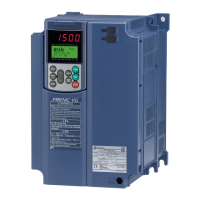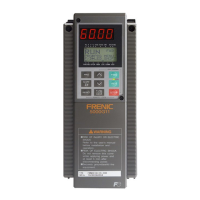NOTES
Application to standard motors
• Driving a 460V standard motor
When driving a 460V standard motor by an inverter
with long cable lengths, damage may occur in the
insulation of motor. Use the output circuit filter
(OFL) if necessary after confirmation with the motor
manufacturer
.The use of Fuji Electric Motor does
not require the output circuit filter because of its
reinforced insulation.
•
Torque characteristics and temperature rise
When the inverter is used to operate a standard
motor, the temperature rises higher than during
operation from a commercial power supply. The
cooling effect decreases in the low-speed range,
reducing the allowable output torque. (If a constant
torque is required in the low-speed range, use a
Fuji inverter motor or a motor equipped with a
separately ventilating fan.)
• Vibration
Use of an inverter does not increase vibration of a
standard motor, but when the motor is mounted to a
machine, resonance may be caused by the natural
frequencies including the natural frequency of the
machine system.
* We recommend that you use a rubber coupling or
anti-vibration rubber.
* We also recommend that you use the inverter
jump frequency control function to avoid resonance
point in the motor operation.
Note that operation of a 2-pole motor at 60Hz or
over may cause abnormal vibration.
• Noise
When an inverter drives a standard motor, the
motor noise level increases compared with driven
by commercial power. To reduce noise, set the
inverter carrier frequency at a high level. High-
speed operation at 60Hz or over can result in more
noise.
Application to special motors
•
Explosion-proof motors
When driving an explosion-proof motor with an
inverter, use a combination of a motor and an
inverter that has been approved in advance. Such
approved products are available in our special
product series. Contact Fuji for details.
• Submersible motors and pumps
These motors have a larger rated current than
standard motors. Select the inverter capacity so
that these motors can run within the inverter rated
current. These motors differ from standard motors
in thermal characteristics.
Set a small value according to the thermal time
constant of motor for setting electronic thermal relay
function.
• Brake motors
For the motors with parallel-connected brakes,
connect the brake power cable to the inverter's
input side (primary circuit). If the brake power is
connected to the output side (secondary circuit), the
power may not be supplied to the brake, resulting in
non-actuation of the brake. Do not use inverters for
driving motors equipped with series-connected
brakes.
• Geared motors
When the power transmission mechanism uses an
oil-lubricated gearbox or speed changer/reducer,
continuous motor operation at low speed may
cause poor lubrication.
• Synchronous motors
Synchronous motors cannot be driven by FRENIC-
Mini inverter.
• Single-phase motors
Single-phase motors are not suitable for inverter-
driven variable speed operation. Use three-phase
motors.
* Even if a single-phase power supply is available,
use a three-phase motor, because the inverter
provides three-phase output.
Combination with peripheral device
• Installation location
Use the inverter in an ambient temperature range
between -10 to 50°C (14 to 122°F).
The inverter and braking resistor surfaces become
hot under certain operating conditions. Install an
inverter on non-flammable material.
• Installing a circuit breaker
To protect the circuit from overcurrent, install a
recommended molded-case circuit breaker (MCCB)
or a ground-fault circuit interrupter (GFCI)
(equipped with overcurrent protection function) on
the inverter's input side (primary circuit). Ensure
that the circuit breaker capacity does not exceed
the recommended value.
•
Magnetic contactor on the output side (secondary circuit)
When a magnetic contactor is installed on the
inverter's output side (secondary circuit) for such a
purpose as switching the power to the commercial
power supply, ensure that both inverter and motor
are stopped before switching. Remove the surge
suppressor integrated with the magnetic contactor.
•
Magnetic contactor on the input side (primary circuit)
Avoid frequent open/close (more than once an
hour) of the circuit using the magnetic contactor on
the input side (primary circuit). It may cause
malfunction of the inverter. If frequent starts and
stops are required, use signals to the control
terminals FWD or REV.
• Protecting the motor
When you drive a motor with an inverter, the motor
can be protected with an electronic thermal relay
function of the inverter. In addition to the operation
level, set the motor type (standard motor, inverter
motor). For high-speed motors or water-cooled
motors, set a small value in the thermal time
constant to protect the motor in combination with
the “cooling system OFF” signal. When driving
several motors with an inverter, connect a thermal
relay to each motor and turn on the inverter’s
electronic thermal relay function. If you connect the
motor thermal relay to the motor with a long cable,
high-frequency current may flow into the wiring
stray capacitance. This may cause the relay to trip
at a current lower than the set value for the thermal
relay. If this happens, lower the carrier frequency or
use the output circuit filter (OFL).
• Power-factor correcting capacitor
Do not mount the power-factor correcting capacitor
in the inverter primary circuit. (Use the DC reactor
to improve the inverter power factor.) Do not use
the power-factor correcting capacitor in the inverter
secondary circuit. Overcurrent trip will occur,
disabling motor operation.
• Reducing noise
Use of filter and shielded wires are typical measures
against noise that meets EMC Directives. For
details, refer to the operation procedure manual.
• Measures against surge current
If OV trip occurs while the inverter is stopped or
operated under a light load, it is assumed that the
surge current is generated by open/close of the
phase-advancing capacitor in the power system.
* Connect a DC reactor to the inverter
.
• Megger test
When checking insulation resistance of the inverter,
use a 500V megger and follow the instructions
described in the instruction manual.
Wiring
• Control circuit wiring length
When using remote control, limit the wiring length
between the inverter and operator box to 65.6ft
(20m) or less and use twisted shielded cable.
• Wiring length between inverter and motor
If long wiring is used between the inverter and the
motor, the inverter will overheat or trip because of
overcurrent (under the influence of high-frequency
current flowing into the stray capacitance) in the
wires connected to the phases. Ensure that the
wiring is shorter than 164ft (50m) for models 5HP or
smaller, shorter than 328ft (100m) for 7.5HP or
larger. If these lengths must be exceeded, lower the
carrier frequency or mount an output circuit filter
(OFL).
When wiring is longer than 164ft (50m), and
Dynamic torque-vector control is selected, execute
off-line tuning.
• Wiring size
Select a cable with a sufficient capacity by referring
to the current value or recommended wire size.
• Grounding
Securely ground the inverter using the grounding
terminal.
Selecting inverter capacity
• Driving standard motor
Select an inverter from the capacity range of
nominal applied motors shown in the inverter
standard specifications table. When large starting
torque is required or acceleration or deceleration is
required in a short time, select an inverter with a
capacity one size greater than the standard.
• Driving special motor
Select an inverter that meets the following condition:
Inverter rated current > Motor rated current
Transportation, storage
When transporting or storing inverters, select the
procedures and places that meet the environmental
conditions given in the inverter specifications.
Ensure that the above environmental conditions are
met also when transporting an inverter mounted to
a machine.
Fuji Electric Corp. of America
Printed on 100% recycled paper

